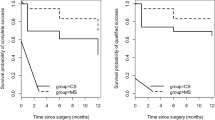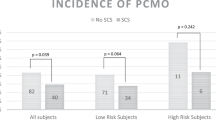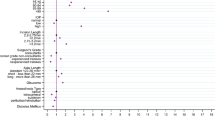Abstract
Aims To evaluate the role of the superior rectus bridle suture in the development of post cataract blepharoptosis.
Methods We compared the incidence of postoperative ptosis in two groups of patients undergoing cataract extraction. In the first group (32 patients), a temporal corneal approach was employed with no superior rectus bridle suture. In the second group (38 patients), a superior approach with a bridle suture was used. Both groups of patients underwent phacoemulsification with the use of peribulbar anaesthesia, a pressure lowering device and a speculum. We recorded the lid position at least 12 weeks following surgery and determined the degree of postoperative ptosis. Two-sided Fischer’s Exact Test was used to test for significant difference between the two groups (using a statistical software package Instat Version 3.0 for Windows).
Results Taking 2 mm of ptosis as a significant change, 11.5% of those undergoing temporal section sustained postoperative ptosis whilst it occurred in 12.9% of those who underwent a superior approach.
Conclusions The presence or absence of the superior rectus bridle suture and the site of the ocular wound do not significantly contribute to the incidence of postoperative ptosis. We would suggest that the causative factors are peribulbar anaesthesia, a pressure lowering device and the use of the speculum.
Similar content being viewed by others
Introduction
Blepharoptosis following intraocular surgery is a well-recorded complication. The basic pathophysiology is believed to be damage to the levator aponeurosis complex and many aetiological factors have been proposed. These include a local anaesthetic injection into the eyelid, peribulbar anaesthesia, and traction on the superior rectus muscle, fashioning of a superior conjunctival flap, prolonged postoperative patching and lid oedema.1 However placement of a superior rectus bridle suture has been suggested as being the principal factor.1,2,3
In this retrospective study we attempt to identify the significance of a superior rectus bridle suture in the causation of postoperative ptosis.
Materials and methods
This retrospective study reviewed 66 patients who had undergone small-incision phacoemulsification performed by two consultant surgeons. Thirty-eight patients underwent surgery via a superior scleral tunnel with the use of a superior rectus (SR) bridle suture (Group A) and 28 patients underwent surgery via a temporal corneal approach with no SR bridle suture (Group B). The type of operation performed was based upon the Consultant’s surgical preference rather than any ocular factors. Peribulbar anaesthesia (using a mixture of 5 ml 2% lignocaine, 5 ml 0.5% bupivicaine and 1500 IU hyaluronidase), a pressure lowering device kept on for 10 min at a pressure of up to 25 mmHg, a speculum and similar adhesive drapes were used in all patients. In this group of patients there were 41 females and two males with an average age of 75 years (range 49–91). None of the patients chosen had any prior intraocular surgery. Operating time was between 30–40 min.
All patients were recalled for examination with an average follow-up of 12 weeks and the level of ptosis was determined both clinically and photographically, with the fellow unoperated eye being used as control (any frontalis overaction was negated). The same observer for an assessment of palpebral aperture, levator function and skin crease examined all patients. In the control eye the palpebral aperture was between 11–12 mm. A Polaroid camera was used with eyes in the primary position. All the pictures were analysed by the same consultant oculoplastic specialist. They were classified as no ptosis, minimal ptosis (<2 mm difference) and significant ptosis (>2 mm difference).
Two-sided Fischer’s Exact Test was used to test for significant difference between the two groups (using a statistical software package Instat Version 3.0 for Windows).
Results
Clinically 4/38 patients (10.5%) of those who underwent superior approach with SR bridle suture and 3/28 patients (10.7%) of those who had a temporal corneal approach were recorded as having significant ptosis of 2 mm (Figure 1) (P = 1).
Six per cent of the patients (4/66) were considered to have significant ptosis by the masked oculoplastic specialist based on the Polaroid pictures. Of these four patients, 50% belonged to each of the two groups.
In none of the 66 patients was the levator function noted to be abnormal (normal was taken to be between 12–15 mm) and in only one out of the seven patients noted to have had significant ptosis was there actually a raised skin crease of about 1 mm in the operated eye when compared with its unoperated fellow (see Figure 2, Figure 3, Figure 4).
Discussion
All the patients in our study underwent routine uncomplicated small incision phacoemulsification. The operation was standardised in terms of similar peribulbar anaesthesia, speculae, pressure lowering device and adhesive drapes. Only the site of the ocular wound and the use of the superior rectus bridle suture differed.
The incidence of postoperative blepharoptosis in these two groups was 10% which was similar to other studies.1,2,4 No preoperative measurements were taken because, since there was no surgical selection, any preoperative ptosis would have randomised between the two groups. Further, previous studies have shown that any pre-existing ptosis does not worsen postoperatively and hence any change relative to the fellow control eye would be the same.5
Our results suggest that ptosis is not influenced by either the ocular wound site or the SR bridle suture. This is in line with work by Linberg et al who described ptosis developing in patients after radial keratotomy was not attributed to the use of the bridle suture because it was not used during the operation.6 In this study the speculum was proposed as the main factor causing levator complex damage. Similarly a study by Singh et al suggested that the speculum was the main cause of the damage.7
Further, Deady et al showed that patients who developed a superior rectus haematoma during insertion of the bridle suture still did not develop postoperative ptosis.5
Contrary to our findings Kaplan et al suggested that the superior rectus bridle suture is the principle factor inducing damage to the levator complex.1 In this study the highest incidence of postoperative ptosis was in those patients who had both a Van Lint type of local anaesthetic and the superior rectus bridle suture.
The incidence of postoperative ptosis suggests that some factor in relation to ocular surgery must induce levator complex weakening.
Clinical and laboratory-based study has shown that in postoperative blepharoptosis there is disinsertion of the levator aponeurosis complex caused by eyelid oedema.4 This eyelid oedema could be induced by a multiple of pre- and per-operative factors. Peribulbar anaesthesia with its initial myotoxic effect8 and the eyelid speculum, which would compress the upper lid against the orbital bones and thereby reduce the bloodflow to the levator muscle and so induce inflammation, would contribute to this oedema.9 Such a combination of factors would inherently damage an already weakened levator complex due to involutional changes. Further compression with a pressure-lowering device would augment damage to the already weakened levator fibres. It is possible that the high incidence of ptosis found in those patients who underwent a Van Lint local anaesthetic with the superior rectus bridle suture in the Kaplan et al study1 was due to the relative lid swelling induced by the local anaesthetic with the superior rectus bridle suture acting as an additional factor compounding the damage already inflicted by the anaesthetic.
Even though the incidence of postoperative ptosis in our series was 10%, it does not seem to become a persistent problem as shown in a recent clinical series of 200 patients undergoing clear corneal phacoemulsification wherein no significant ptosis was detected 6 months after the operation.10
Conclusion
Our small study demonstrates that a superior rectus bridle suture is not the main cause for postoperative ptosis. We suggest that a combination of factors including a local anaesthetic, compression with a pressure-lowering device and forced lid opening with a wire speculum may all be responsible for levator complex disruption and postoperative ptosis. Our incidence of postoperative ptosis of 10% is broadly in line with other studies. However based on a recent clinical series this does not seem to remain a persistent problem in the long term.
References
Kaplan LJ, Jaffe NS, Clayman HM . Ptosis and cataract surgery. A multivariant computer analysis of a prospective study. Ophthalmology 1985; 92: 237–242
Alpar JJ . Acquired ptosis following cataract and glaucoma surgery. Glaucoma 1982; 4: 66–68
Shiue O, Ko L-S . The study of blepharoptosis after cataract surgery. J Formosan Med Assoc 1987; 86: 1227–1231
Paris GL, Quickert MH . Disinsertion of the aponeurosis of the levator palpebrae superioris muscle after cataract extraction. Am J Ophthalmol 1976; 81: 337–340
Deady JP, Price NJ, Sutton GA . Ptosis following cataract and trabeculectomy surgery. Br J Ophthalmol 1989; 73: 283–285
Linberg JV, McDonald MG, Safir A, Googe JM . Ptosis following radial keratotomy. Ophthalmology 1986; 12: 1509–1512
Singh SK, Sekhar GC, Gupta S . Aeitology of ptosis after cataract surgery. J Cat Refr Surg 1997; 23: 1409–1413
Ranin EA, Carlson BM . Postoperative diplopia and ptosis. A clinical hypothesis based on the myotoxicity of local anaesthetics. Arch Ophthalmol 1985; 103: 1337–1339
Ropo A, Ruusuvaara P, Nikki P . Ptosis following periocular or general anaesthesia in cataract surgery. Acta Ophthalmol 1982; 70: 262–265
Chua CN, Ahad M, Jones CA . Ptosis following phacoemulsification Presented as a free paper at the European Society of Oculoplastic and Reconstructive Surgery (ESOPRS) meeting in June 2001 in Santiago, Spain. Manuscript in preparation
Author information
Authors and Affiliations
Corresponding author
Additional information
No proprietary interest of funding
Rights and permissions
About this article
Cite this article
Patel, J., Blount, M. & Jones, C. Surgical blepharoptosis—the bridle suture factor?. Eye 16, 535–537 (2002). https://doi.org/10.1038/sj.eye.6700022
Received:
Accepted:
Published:
Issue Date:
DOI: https://doi.org/10.1038/sj.eye.6700022
Keywords
This article is cited by
-
Incidence and risk of ptosis following ocular surgery: a systematic review and meta-analysis
Graefe's Archive for Clinical and Experimental Ophthalmology (2019)
-
Postsurgical ptosis associated with intraoperative eyelid dilatability
Spektrum der Augenheilkunde (2017)
-
Influence of upper and temporal transconjunctival sclerocorneal incision on marginal reflex distance after cataract surgery
BMC Ophthalmology (2016)
-
Mechanical testing of lid speculae and relationship to postoperative ptosis
Eye (2013)







